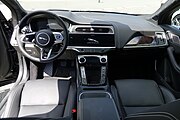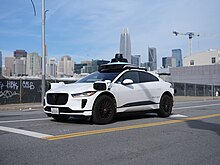Jaguar I-Pace
| Jaguar I-Pace | |
|---|---|
 | |
| Overview | |
| Manufacturer | Jaguar Land Rover |
| Production | 2018–present |
| Assembly | Austria: Graz (Magna Steyr) |
| Designer | Ian Callum |
| Body and chassis | |
| Class | Compact luxury crossover SUV |
| Body style | 5-door coupé SUV |
| Layout | Dual-motor, all-wheel-drive |
| Platform | JLR D7e |
| Powertrain | |
| Electric motor | Permanent magnet synchronous motor x2 200 PS (150 kW) 348 N⋅m (257 lbf⋅ft) (total 400 PS (290 kW) 696 N⋅m (513 lbf⋅ft)) |
| Transmission | 1-speed direct-drive reduction |
| Battery | 90 kW·h lithium ion |
| Electric range |
EPA: 246 miles (396 km) WLTP: 292 miles (470 km) |
| Plug-in charging |
|
| Dimensions | |
| Wheelbase | 2,990 mm (117.7 in) |
| Length | 4,682 mm (184.3 in) |
| Width |
|
| Height | 1,565 mm (61.6 in) |
| Kerb weight | 2,133 kg (4,702 lb) |
The Jaguar I-Pace (stylised as I-PACE) is a battery-electric crossover SUV produced by Jaguar Land Rover (JLR) under their Jaguar marque. The I-Pace was announced in March 2018, European deliveries began in June 2018 and North American deliveries started in October 2018. Amid slow sales Jaguar has announced that the I-Pace will be discontinued by 2025.
Development

The Jaguar I-Pace was designed by Ian Callum. The concept version of the car, described as a five-seater sports car, was unveiled by JLR at the 2016 Los Angeles Motor Show and shown on-road in London in March 2017.
The I-Pace is built by contract manufacturer Magna Steyr in Graz, Austria, and the production version of the I-Pace was revealed in Graz on 1 March 2018.
Some of the electric drive technology has come out of the Jaguar I-Type electric Formula E racing car programme, and the concentric motors were developed by JLR engineer Dr. Alex Michaelides.
Specifications
-
 Side
Side -
 Rear
Rear -
 Interior
Interior
The Jaguar I-Pace launched with a WLTP-rated range of 292 miles (470 km) and an EPA-rated range of 234 miles (377 km). In December 2019, software enhancements were released to increase range to an EPA-rated range of 246 miles (396 km). The car has a wade depth of 500 mm (20 in). The rear boot holds 656 litres (23 cu ft), along with 28 litres (1 cu ft) of front boot space. The drag coefficient is 0.29.
The car has all-wheel drive via two motors powered by a 90 kWh LG Chem lithium-ion battery with a battery management system developed by JLR. Each motor delivers 197 hp (147 kW) and 258 lb⋅ft (350 N⋅m) of torque, for a total power of 395 hp (295 kW) and total torque of 516 lb⋅ft (700 N⋅m). The 0–62 mph (0–100 km/h) time is 4.8 seconds, and the top speed is electronically limited to 124 mph (200 km/h).
The battery contains 432 pouch cells. It can charge from 0 to 80 per cent in 85 minutes using 50 kW DC charging, or 45 minutes using a 100 kW charger. Home charging with an AC wall box (7 kW) achieves the same state of charge in 10 hours. As the I-Pace was initially released with a single-phase 7 kW AC charger, a one-hour charge, would add around 30 km (19 miles) of range. Later 2021 models had 11 kW AC charging, at single-phase or three-phase, depending on market.
The car comes with a smartphone app which can locate the car, report on its locking, alarming, and charging status, and start its battery preconditioning and/or cabin heating/cooling.
Awards

The I-Pace has won 62 international awards. In March 2019, it won the European Car of the Year award, the first Jaguar to win the award. In April 2019, it became the 2019 World Car of the Year, and won Best Design and Best Green Car awards.
Safety
In December 2018, the European New Car Assessment Programme (NCAP) awarded the Jaguar I-Pace a 5-star safety rating.
| Test | Points | % |
|---|---|---|
| Overall: |
|
|
| Adult occupant: | 34.8 | 91% |
| Child occupant: | 40.0 | 81% |
| Pedestrian: | 35.3 | 73% |
| Safety assist: | 10.6 | 81% |
Racing
Jaguar I-Pace eTrophy (Racecar)
The Jaguar I-Pace has a race-prepped version called the I-Pace eTrophy, a development of the I-Pace by Jaguar Special Vehicle Operations.
Series
In September 2017, Jaguar announced their single-make racing series for the I-Pace, called eTrophy, after the racecar of the same name.
On 24 August 2018, the Jaguar I-Pace set a new EV lap record at Laguna Seca Racetrack in California.
Sales
| Year | Europe | United States |
|---|---|---|
| 2018 | 6,490 | 393 |
| 2019 | 12,232 | 2,594 |
| 2020 | 13,444 | 1,546 |
| 2021 | 8,079 | 1,409 |
| Total | 40,245 | 5,942 |
Partnership for autonomous ride service

In 2018, Waymo selected the Jaguar I-Pace for use in its autonomous ride-hailing service, placing an order for 20,000 vehicles.
Wireless charging project
In June 2020, Jaguar announced its support for a wirelessly-charged taxi project in Oslo, Norway. Jaguar will give 25 I-Pace vehicles to taxi company Cabonline, which will use the vehicles to test the charging infrastructure on taxis in the Norwegian capital. Ralf Speth, Jaguar Land Rover's chief executive said "The taxi industry is the ideal test bed for wireless charging, and indeed for high-mileage electric mobility across the board".


